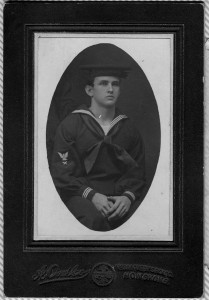John Sanders
Special Collections & Archives
Dudley Knox Library
Naval Postgraduate School
Monterey, California
Wednesday, April 26, 1911: “Got into tail of typhoon about 5 a.m. Sea roughest experienced yet. Lucky we are heading into it. Eased up a bit about 8 p.m. Maintained 8 to 12 knots thro it. NY and Albany pulled off some struts.”
Friday, April 28, 1911: “Sighted land at 11:50 a.m. Anchor at Nagasaki at 12:38 to buoys right in front of town. This is or looks like nice place. Quite a puzzle to get into harbor. Received 5 bags of mail.”
Wednesday, October 18, 1911: “Just had time to grab breakfast and get ready to go ashore in landing force. Went in American party. Forces from all ships guarding concessions. We went to Japanese consulate. Chink gunboats fired on land forces on both sides of river just below us. Everybody up in arms. Rebels victorious all day.”
These entries were written in pencil in a 3-inch by 6-inch leather diary that has pre-printed tide tables for Boston and New York harbors and a list of American presidents. William Howard Taft, the nation’s 27th chief executive, was in office when Guy Harter enlisted in the Navy and subsequently boarded an Asiatic Fleet gunboat en route to the Yangtze River in 1911, his uniform bearing the insignia of a yeoman.
Many of Harter’s diary entries speak only of boredom and quiet along the river. A few, however, capture the action, mystery and uncertainty of naval forces sent to protect American interests in China during the revolutions in 1911 and 1912.
Harter’s pocket diary is just the beginning of a remarkable journey into the early 20th-Century Orient captured by the pencil, typewriter and camera lens of this sailor.
Harter’s photo scrapbook shows crews reconstructing the USS Monocacy (PG-20) and the USS Palos (PG-16) in 1913, the first gunboats designed and delivered by the Navy to ply the upper reaches of the treacherous Yangtze. Photos capture Harter and shipmates at work and on liberty as well as scenes of rebel forces during an attack and the burning of Nanking in 1912. Another scrapbook contains a brilliant assortment of menus, playbills, programs, receipts, stamps, news clippings – and a red scrap of fabric Harter has labeled, “What was left of the Wilmington’s Ensign after the typhoon had ceased blowing Sunday afternoon. August 17, 1913, 4:30 p.m.” Beneath this, Harter has written, “Hong Kong, China.”
His chronicles of life as a River Rat offer deep perspective for the scholar interested in American naval action and U.S.-China relations a century ago.
His records are among several personal diaries and photo scrapbooks created by Yangtze River Patrol sailors. This collection of River Rat memorabilia and documents give added perspective to the Navy History & Heritage Command’s ten linear feet of documents in its China Repository and to the ship models and artifacts held by the United States Navy Memorial.
The Yangtze River Patrol Collection includes the only known set of the Yangtze River Patroller newsletter. The newsletter focuses largely on reunion plans and social news of members of the Yangtze River Patrol Association however each issue typically includes a personal recollection of naval life in China.
Harter’s scrapbooks are among the records that have been digitized and are readily accessible on the Dudley Knox Library’s web at http://library.nps.edu/special-collections.
For additional information about the collection and other holdings, contact John Sanders, Special Collections Manager, Dudley Knox Library, Naval Postgraduate School. E-Mail: jfsander@nps.edu; Phone: 831-656-3346.
(Return to the July 2015 Table of Contents)
 John Sanders is a former Naval Postgraduate School public affairs officer who, with support and guidance from university librarian Eleanor Uhlinger, established the NPS archives. His other works have appeared in publications such as Aerospace America and the Dictionary of Professional Military Education.
John Sanders is a former Naval Postgraduate School public affairs officer who, with support and guidance from university librarian Eleanor Uhlinger, established the NPS archives. His other works have appeared in publications such as Aerospace America and the Dictionary of Professional Military Education.



16 Responses to Inside the Archives: The Yangtze River Patrol Collection